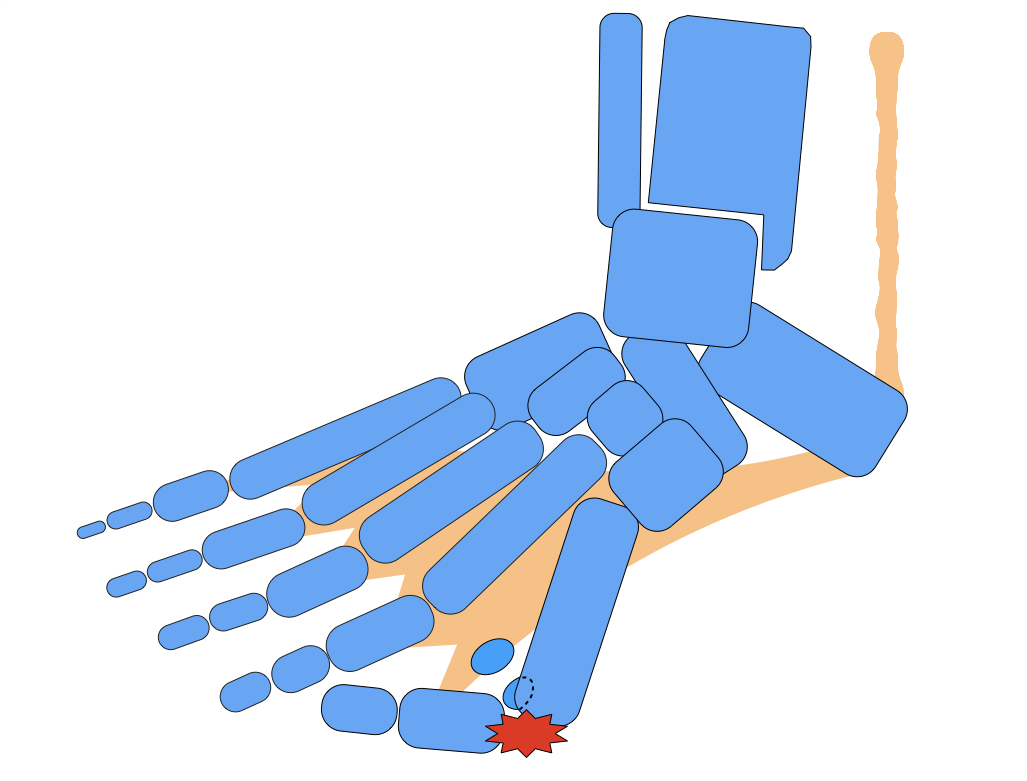Treatable ConditionsSupervised by Foot Clinic Omotesando
Bunion (Hallux Valgus)
A bunion is not simply a problem of the big toe itself, but a condition caused by skeletal deformities of the entire foot, often influenced by genetics or other medical conditions. The overall foot structure collapses, resulting in the big toe bending outward in a “V” shape. As the condition worsens, the toe becomes severely angled, and the bone at the base protrudes outward.
Since the big toe is not the root cause, it is crucial to examine which part of the foot structure is problematic. Simply using commercial toe correctors or taping will not fundamentally resolve the issue.
The basic treatment for mild cases involves correcting the foot’s overall structure using medical insoles (orthotics) along with gait training.
If the deformity progresses further, corrective surgery for the big toe may be required.
Bunion surgery at Foot Clinic Omotesando generally requires hospitalization. However, even when both feet are operated on simultaneously, patients can start walking from the day after surgery. No casts are required, and patients can wear regular shoes shortly after. There are minimal restrictions on daily activities.
The implants used in surgery are bio-absorbable, meaning no additional surgery is required to remove them later (subject to foot condition and surgeon’s decision).
Once the bunion deformity is corrected, proper toe-off during walking becomes possible, improving gait and helping prevent other foot issues.
* For details about the causes of bunions and surgical procedures, please refer to this page (Japanese).
* Even with surgery on both feet, discharge is possible once walking becomes stable. Hospitalization duration depends on the patient’s progress. Walking rehabilitation starts from the day after surgery. For details, please contact Foot Clinic Omotesando.
-

Before Surgery
-

After Surgery
-

Preoperative X-ray
-

Postoperative X-ray
Treatable Conditions Supervised by Omotesando Foot Clinic
- Joint Pain & Deformities
- Bunion (Hallux Valgus)
- Hallux Rigidus
- Hammer Toe / Claw Toe / Mallet Toe
- Gout Attack
- Lisfranc Joint Disorder
- Rheumatoid Arthritis
- Osteoarthritis of the Ankle
- Toenail Disorders
- Ingrown Toenail (Onychocryptosis)
- Thickened Toenail (Onychauxis)
- Double Toenail
- Toenail Fungal Infection (Onychomycosis)
- Muscle, Tendon, and Ligament Pain
- Plantar Fasciitis
- Achilles Enthesopathy
- Peroneal Tendon Subluxation
- Posterior Tibial Tendon Dysfunction
- Flexor Hallucis Longus Tendinitis
- Bone-Related Pain
- Sesamoiditis (Pain in the Big Toe)
- Metatarsal Head Pain
- Os Trigonum Syndrome
- Accessory Navicular Syndrome
- Osteochondrosis (Sever’s Disease etc.)
- Sinus Tarsi Syndrome
- Stress Fracture
- Foot Numbness
- Morton's Neuroma
- Tarsal Tunnel Syndrome
- Diabetic Peripheral Neuropathy
- Foot Lumps & Lesions
- Corns / Calluses / Warts
- Subungual Exostosis
- Glomus Tumor
- Plantar Fibromatosis
- Ganglion Cyst
- Epidermoid Cyst (Atheroma)
- Sports & Foot Health
- Causes of Pain (Threshold Changes)
- Pes Anserine Bursitis (Inner Knee Pain)
- Iliotibial Band Syndrome (Outer Knee Pain)
- Shin Splints
- Ankle Sprain (Lateral Ligament Injury)
- Lisfranc Ligament Injury
- Common Pediatric Foot Conditions
- The Arch as the Foundation of Growth
![Foot Clinic OMOTESANDO [Ashi no Clinic OMOTESANDO]](/img/en/cmn/logo1.svg)





